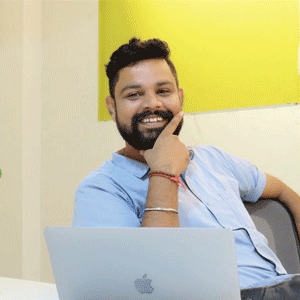 In this dynamic technological landscape, the definition of a perfect CTO has changed drastically. Driving innovation, an ideal CTO enables customers as well as his team to not only adapt to current technological developments but also to be braced for future evolution, all while protecting their consumers’ data from cybercriminals. Standing synonymous with the definition is Rahul Lahoria - CTO & Co-Founder of Mogi I/O, an avant-garde video delivery platform. Under his aegis, Mogi I/O has been successful in endowing its clients with next-gen video and image delivery SaaS that helps video creators and providers launch their own OTT, podcast, and short video platforms.
In this dynamic technological landscape, the definition of a perfect CTO has changed drastically. Driving innovation, an ideal CTO enables customers as well as his team to not only adapt to current technological developments but also to be braced for future evolution, all while protecting their consumers’ data from cybercriminals. Standing synonymous with the definition is Rahul Lahoria - CTO & Co-Founder of Mogi I/O, an avant-garde video delivery platform. Under his aegis, Mogi I/O has been successful in endowing its clients with next-gen video and image delivery SaaS that helps video creators and providers launch their own OTT, podcast, and short video platforms.The excerpt below is from Rahul's exclusive interview with CIO TechOutlook magazine, in which he addresses the changing roles of a CTO and how he has been steering transformation at Mogi I/O.
According to you, what are the major factors that are leading to the shift in the role of the CTO in today’s enterprise?
As technology continues to penetrate the tier-3 and tier- 4 realms, the rising demands of consumers are driving an upheaval in new technologies and trends. This, in turn, has led the tech teams and a CTO of a company to work around the clock daily. Today, tech teams have to create technology that fits the needs of people, irrespective of their education. Replacing the traditional planning committees, the current data-driven environment urges businesses to improve their innovations based on the live data collected through clients’ feedback.
In addition, since education is becoming more accessible, anybody in a remote village can learn how to hack a system. Hence, companies are witnessing an increase in the frequency and complexity of cybersecurity threats. Rather than following a conventional method of focusing on one plan, CTOs need to collaborate with every key member of an organization, like the CEO, a CMO, or a CFO, as well as the customers, to devise a safer ecosystem.
How do you overcome the strategic challenges faced by CTOs when it comes to identifying and implementing new technologies that could benefit their organization?
It is extremely imperative, yet difficult, for businesses to meet the needs of the basic nature of human beings, which is to want everything in an instant. Hence, apart from helping the customers stay current with technological trends, it is also critical for a CTO to identify the short term and long-term needs of every business unit, and strike a perfect balance between the two. While one can stay informed about the technological evolution through resources like technological publications and networking with tech industry leaders, communicating with our stakeholders about the timeline, benefits, and implications of new technologies can help them cater to the needs of their consumers effectively.
What role do you play as a CTO in driving the digital transformation at Mogi I/O? How do you balance the need for
innovation with concerns around cybersecurity and data privacy?
At Mogi I/O, leading technological initiatives is one of the many hats I wear. As a part of the endeavor, I conduct continual market research and analysis to strategically move and improve technology stacks as per the everevolving needs of tech-savvy customers. The extensive scrutiny also helps in understanding how we can use the data to make digital transformation effective and detailed. I also ensure that the infrastructure is scalable and flexible enough to host several systems and focus on structuring a new road map for potential technological adoption in an organization. At Mogi, we use the opensource framework of Kubernetes to mold apps to scale and be flexible.
I own the responsibility of building and nurturing a strong tech team by hiring the right resources who share the same flair for quick adaptability. As a CTO, I understand the intricacy of integrating new technologies with legacy systems, and we hence evaluate the existing resources, technologies, and goals of our stakeholders, before upgrading their tech systems.
As a B2B company, Mogi I/O deals with a massive amount of sensitive data. We follow a phased approach and have strong migration policies that facilitate easy migration to newer systems, without breaching the legal or security policies present in their organization. By following a risk-based process, my team and I strive to foresee and quell potential cyber-attacks by strengthening the products and security measures through a thorough evaluation of old publications and case studies. We also focus on educating our employees about cybercrimes and risks to assist them in making informed decisions at an early stage.
How do you manage the demands of different stakeholders within your organization? Based on the above-mentioned changing market environment, what are your plans for the future of Mogi I/O?
At Mogi, we continuously seek to build a strong relationship with our stakeholders as well as the team and have implemented a channel for clear and open communication between them, through which they can freely discuss their priorities and concerns. If we share our goals or road map with them, we can meet each other’s demands. We have developed a technological roadmap that is clearly communicated to all stakeholders including vendors and customers. The employees are also trained to be receptive to feedback, which pushes them to refine the techniques and solutions.
We have forged a culture of innovation at Mogi I/O. Instead of spending three months on an older solution, we are happy to invest four months on an innovative breakthrough. Currently, we are engaged in the process of developing an AI-based edutech solution. The product aims at assisting educators to concentrate solely on guiding the students academically, by reducing the additional administrative workload, thus revolutionizing pedagogy.
At Mogi I/O, leading technological initiatives is one of the many hats I wear. As a part of the endeavor, I conduct continual market research and analysis to strategically move and improve technology stacks as per the everevolving needs of tech-savvy customers. The extensive scrutiny also helps in understanding how we can use the data to make digital transformation effective and detailed. I also ensure that the infrastructure is scalable and flexible enough to host several systems and focus on structuring a new road map for potential technological adoption in an organization. At Mogi, we use the opensource framework of Kubernetes to mold apps to scale and be flexible.
I own the responsibility of building and nurturing a strong tech team by hiring the right resources who share the same flair for quick adaptability. As a CTO, I understand the intricacy of integrating new technologies with legacy systems, and we hence evaluate the existing resources, technologies, and goals of our stakeholders, before upgrading their tech systems.

Apart from helping the customers stay current with technological trends, it is also critical for a CTO to identify the short-term & long-term needs of every business unit, & strike a perfect balance between the two
As a B2B company, Mogi I/O deals with a massive amount of sensitive data. We follow a phased approach and have strong migration policies that facilitate easy migration to newer systems, without breaching the legal or security policies present in their organization. By following a risk-based process, my team and I strive to foresee and quell potential cyber-attacks by strengthening the products and security measures through a thorough evaluation of old publications and case studies. We also focus on educating our employees about cybercrimes and risks to assist them in making informed decisions at an early stage.
How do you manage the demands of different stakeholders within your organization? Based on the above-mentioned changing market environment, what are your plans for the future of Mogi I/O?
At Mogi, we continuously seek to build a strong relationship with our stakeholders as well as the team and have implemented a channel for clear and open communication between them, through which they can freely discuss their priorities and concerns. If we share our goals or road map with them, we can meet each other’s demands. We have developed a technological roadmap that is clearly communicated to all stakeholders including vendors and customers. The employees are also trained to be receptive to feedback, which pushes them to refine the techniques and solutions.
We have forged a culture of innovation at Mogi I/O. Instead of spending three months on an older solution, we are happy to invest four months on an innovative breakthrough. Currently, we are engaged in the process of developing an AI-based edutech solution. The product aims at assisting educators to concentrate solely on guiding the students academically, by reducing the additional administrative workload, thus revolutionizing pedagogy.





